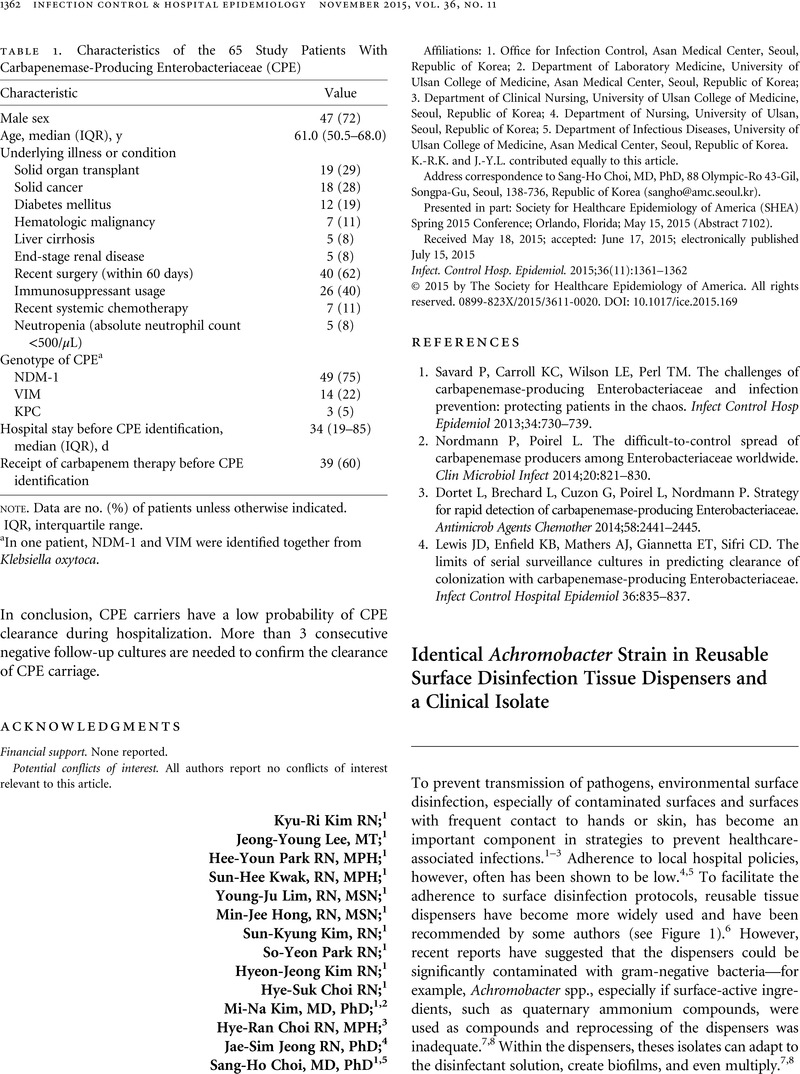Crossref Citations
This article has been cited by the following publications. This list is generated based on data provided by Crossref.
Günther, Frank
Merle, Uta
Frank, Uwe
Gaida, Matthias M.
and
Mutters, Nico T.
2016.
Pseudobacteremia outbreak of biofilm-forming Achromobacter xylosoxidans – environmental transmission.
BMC Infectious Diseases,
Vol. 16,
Issue. 1,
Clifford, Robert
Sparks, Michael
Hosford, Eve
Ong, Ana
Richesson, Douglas
Fraser, Susan
Kwak, Yoon
Miller, Sonia
Julius, Michael
McGann, Patrick
Lesho, Emil
and
Nychas, George-John
2016.
Correlating Cleaning Thoroughness with Effectiveness and Briefly Intervening to Affect Cleaning Outcomes: How Clean Is Cleaned?.
PLOS ONE,
Vol. 11,
Issue. 5,
p.
e0155779.
Stutzman, Tyler
Sánchez-Vargas, Flor Maria
Nanjappa, Sowmya
Velez, Ana Paula
and
Greene, John N.
2016.
Achromobacter Bacteremia in Patients With Cancer.
Infectious Diseases in Clinical Practice,
Vol. 24,
Issue. 6,
p.
339.
Dubler, S.
Zimmermann, S.
Fischer, M.
Schnitzler, P.
Bruckner, T.
Weigand, M. A.
Frank, U.
Hofer, S.
and
Heininger, A.
2016.
Bacterial and viral contamination of breathing circuits after extended use – an aspect of patient safety?.
Acta Anaesthesiologica Scandinavica,
Vol. 60,
Issue. 9,
p.
1251.
Jeukens, Julie
Freschi, Luca
Vincent, Antony T.
Emond-Rheault, Jean-Guillaume
Kukavica-Ibrulj, Irena
Charette, Steve J.
and
Levesque, Roger C.
2017.
A Pan-Genomic Approach to Understand the Basis of Host Adaptation in Achromobacter.
Genome Biology and Evolution,
Vol. 9,
Issue. 4,
p.
1030.
Kampf, G.
2018.
Adaptive microbial response to low-level benzalkonium chloride exposure.
Journal of Hospital Infection,
Vol. 100,
Issue. 3,
p.
e1.
Kampf, Günter
2018.
Antiseptic Stewardship.
p.
259.
Boyce, John M.
2021.
A review of wipes used to disinfect hard surfaces in health care facilities.
American Journal of Infection Control,
Vol. 49,
Issue. 1,
p.
104.
Boyce, John M.
and
Havill, Nancy L.
2022.
In-use contamination of a hospital-grade disinfectant.
American Journal of Infection Control,
Vol. 50,
Issue. 12,
p.
1296.
2022.
Anforderungen an die Hygiene bei der Reinigung und Desinfektion von Flächen.
Bundesgesundheitsblatt - Gesundheitsforschung - Gesundheitsschutz,
Vol. 65,
Issue. 10,
p.
1074.
Boyce, John M.
2023.
Quaternary ammonium disinfectants and antiseptics: tolerance, resistance and potential impact on antibiotic resistance.
Antimicrobial Resistance & Infection Control,
Vol. 12,
Issue. 1,
Lompo, Palpouguini
Heroes, Anne-Sophie
Agbobli, Esenam
Kühne, Vera
Tinto, Halidou
Affolabi, Dissou
and
Jacobs, Jan
2023.
Bacterial Contamination of Antiseptics, Disinfectants and Hand Hygiene Products in Healthcare Facilities in High-Income Countries: A Scoping Review.
Hygiene,
Vol. 3,
Issue. 2,
p.
136.
Kampf, Günter
2024.
Antiseptic Stewardship.
p.
407.



